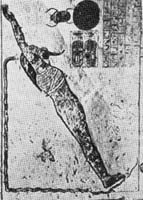The Discovery
Two years ago in Heaven’s Mirror [1], Graham Hancock cited the groundbreaking work of cosmologist Frank Edge. Edge claimed that the Lascaux cave paintings, believed to be around 16,500 years old, represent the efforts of sophisticated Ice Age humans to map the stars. [2]
Now, Edge’s finding has been supported, extended and brought to worldwide attention by the independent work of Dr. Michael Rappenglück. Misinformed journalists and academics are crediting Rappenglück alone with the discovery of the earliest star maps [3], but Rappenglück cites Edge’s findings in his work.
- Graham Hancock, Heaven’s Mirror, 1998, pp.28-29.
- Frank Edge, Aurochs in the Sky, 1995.
- See BBC Online News article by Dr David Whitehouse
The Evidence
A map of the Pleiades, a group of seven stars that form part of the constellation known today as Taurus, is located just over the shoulder of a bull drawn near the entrance to the cave. Spots on the bull itself may represent other stars found in this region of sky.
A map of the “Summer Triangle” (stars Vega, Deneb and Altair) is located in part of the cave’s interior known as the “Shaft of the Dead Man”. The stars are represented by the eyes of three figures – a bull, a bird sitting on a vertical stick, and a strange bird-man. The Summer Triangle is so named because it is especially bright during the summer months. Significantly, 17,000 years ago this star group would have never been below the horizon.
Rappenglück has also uncovered a map of the “Northern Crown” constellation located in a cave in the Pico del Castillo mountains of Spain. This map is thought to be 14,000 years old.
The Implications
The most obvious implication is that, as was argued in Heaven’s Mirror, the traditional view of the zodiac being a Graeco-Babylonian invention is wrong. The association of the Pleiades (part of Taurus) with a bull shows that information, and especially that which is of great importance or transmitted in certain formats (like art and folklore), can be passed down through great stretches of time.
Together with engraved moon maps (such as that from 3,000BC in Knowth, Ireland [4]) and the careful astronomical alignments of prehistoric megaliths (such as the Maltese temples [5]), these Ice Age star maps demonstrate that the heavenly bodies and their positions were of central importance to our distant ancestors. Graham Hancock and others are seeking to understand why.
- To learn more, go to http://users.bigpond.com/kirwilli/dolmen/monuments.htm
- c.f. Serio et al., 1992, Journal for the History of Astronomy Vol 23 pp.107-119
Additional note by Graham Hancock
In 1992 I was faxed an interesting piece of information about the Lascaux cave figures. The information was from a book by Belinda Gore entitled Ecstatic Body Postures: An Alternate Reality Workbook. Gore is a student of anthropologist Dr Felicitas Goodman who “has spent many decades collecting the postures from the art of hunter-gatherer peoples worldwide, having her students try them out to the rhythmic beat of a rattle, and record the results.”
Gore draws special attention to the figure of the strange bird-man hybrid in the “Shaft of the Dead Man” and criticises the interpretation given to it by orthodox scholars:
“A ritual body posture identified among the cave drawings was depicted as a stick figure lying in front of a giant auroch. Various archaeologists speculated that either he had been killed by the aurochs or the drawing related to some kind of hunting magic.
“From the perspective of ecstatic trance, neither of these explanations is correct. First, the man is not dead… Second, the man’s head is a bird mask, and beside him stands a staff with a bird at its head. These suggest that the man is a shaman, journeying as a bird into the Sky World, perhaps with the assistance of a bird who is his spirit helper.
“This was the first spirit-journey posture identified by Dr Goodman, and it was a credit to her skills in observation that she noticed that the body of the shaman was not lying flat. It was, instead, lying at a 37-degree angle. This very precise angle was a hallmark of spirit-journey postures performed by hunters, especially for journeying to the Sky World. For example, this same posture turned up 12,000 years later in Egypt in a drawing of Osiris. [Emphasis added]. Osiris underwent a typical shamanic initiation in which his body was dismembered and then reassembled by his sister before he made his spirit journey to the Upper World. In the drawing Osiris was lying at the same 37-degree angle as the Shaman in the Lascaux cave…”
The similarity of the two figures is, in my view intriguing, especially when we consider the sky religion of the ancient Egyptians and their desire to be transformed into stars after death.
Perhaps Lascaux shows us not only that the constellations were recognised 16,500 years ago but also that sophisticated spiritual ideas have much more ancient origins than has previously been believed.
Another point to note on this matter is raised by my friend John Anthony West in his wonderful book Serpent in the Sky. He shows that complex mathematical proportions are encoded within the posture of the Egyptian figure and that it yields the “Pythagorean” 3:4:5 triangle thousands of years before Pythagoras.
Perhaps the roots of such mathematics are even more ancient than the Egyptians?
Further Reading and Links
Click book titles to see overview/purchase:
- Graham Hancock: Heaven’s Mirror, especially Chapter Two
- Dr. Rappenglück publishes his work on the web, at http://www.infis.org/ (though some of it is currently only in German).
- Florence and Kenneth Wood: Homer’s Secret Iliad
- John Anthony West: Serpent in the Sky: The High Wisdom of Ancient Egypt
- Belinda Gore: Ecstatic Body Postures: An Alternate Reality Workbook
- Felicitas Goodman: Where Spirits Ride the Wind: Trance Journeys and other Ecstatic Experiences
- Felicitas Goodman: Ecstasy, Ritual, and Alternate Reality: Religion in a Pluralistic World







